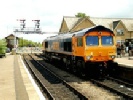Archive Section




A report on the presentation given by Geoff Hobbs, Head of Strategy, Transport for London, London Rail
6th October 2009
An account of the lecture, written by Peter Lindop
Routes
Geoff started off the talk by going through the five routes that London Overground Railway Operations Limited (LOROL, known as Overground) are responsible for: -
Nature of Concession
TfL awarded this to LOROL, for 7 years, starting from 11th November 2007 (with a possible 2 year extension). LOROL is a joint venture between MTR (Hong Kong Metro) and D.B. Schenker. The concession aims to address eight objectives, all of which are measured. They include Improving the Passenger Experience (quality of stations, security, train performance and reliability), increase revenue, introducing new rolling stock, integrating The East London Line into the system, and a 2012 Olympics plan.
Some of these areas have already been met: -
Overground in Numbers
In this section, Geoff showed how the situation is improving (either slightly or in large percentages) from Silverlink days (pre Overground) to current. Charts and graphs from Network Rail, Passenger Focus, as well as LOROL were used. Mystery shoppers have been used to see/report what is going on. Ticket gates have been widely installed, reducing ticket less travel/fraud loss, and increasing security.
Station Improvements
This is being carried out in four stages. Phase 1 was completed in November 2007 (work was started by TfL before the concession started), seeing ticket gates installed and other smaller works. Phase 2 was an initial round of cleaning and repairs, completed summer 2008. Phase 3 has recently started, station refurbishments. Headstone Lane is the first one. Phase 4 will be remodelling, which is currently planned to be several stations on the North London Line, and the Crystal Palace route (a joint TfL/Network Rail venture).
New Trains
Bombardier is building a fleet of 54 electric 3 or 4 car electric units at Derby, at a cost of 260M. For various reasons, delivery is behind schedule. At present only 6 have entered service, following the Stakeholder Preview at Willesden Junction on 3rd June 2009. The Class 378s feature wide walk-
Eight new Class 172 2-
Planned Infrastructure
Network Rail are carrying out major works between Camden Road and Dalston, to improve train frequencies, line capacity and allow modern higher freight containers on the route. Stations will be rebuilt, the two/three track railway will become four (most of the way), with turnback sidings and freight loops installed. All this work does bring bad news though, a large amount of line closures during 2009/2010, but a new timetable from January 2011.
Major work is also being carried out on the Gospel Oak-
More capacity is required at Clapham Junction but how? Reinstating Platform 1 is the obvious answer, however the trackbed now houses a large amount of signalling equipment, which would be awkward to move! Or perhaps doing something in West Yard? This question still requires an answer!
A lot of this work is part of The Olympic Legacy, with funds from Network Rail, Department for Transport, TfL, and the Olympic Development Agency.
Network Expansion
The East London Line is currently being rebuilt, from its days with London Transport. Extended north on the old Broad Street line to Dalston Junction, and Highbury and Islington. Routes south to Crystal Palace and West Croydon, with 10 stations transferred from Southern operation. The final extension to Clapham Junction has now received its funding. The first new electric train ran through from New Cross to Dalston on 5th October. Taking 10 hours, as numerous checks and tests were carried out. Service trains will be much quicker!
Imperial Wharf Station opened on 27th September 2009.
This Week’s News
The first train was in New Cross Depot. 10 stations transferred from Southern (along the West Croydon route). Work started on Highbury and Islington Station. Design work on ELL Phase 2 to Clapham Junction started.
Geoff then showed some photographs, of the new Dalston Junction Station, aerial views of the Shoreditch area, and New Cross Gate depot and operations buildings.
A final slide showed progress, a lot has been achieved already, but there is still a long way to go!
A question/answer session completed this evenings interesting talk. We then thanked Geoff in the usually way.